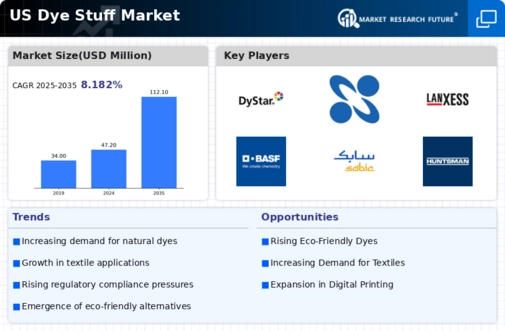Growth of E-commerce Platforms
The rise of e-commerce platforms is significantly impacting the dye stuff market in the US. Online retail has transformed how consumers access dye products, providing convenience and a broader selection. As of November 2025, e-commerce sales in the dye sector are projected to account for approximately 30% of total sales, driven by the increasing preference for online shopping. This shift allows smaller manufacturers to reach a wider audience without the need for extensive physical retail presence. Consequently, the growth of e-commerce is not only expanding market reach but also fostering competition among suppliers, which may lead to more innovative and diverse product offerings in the dye stuff market.
Consumer Demand for Customization
In the dye stuff market, there is a notable trend towards consumer demand for customization. As consumers increasingly seek personalized products, manufacturers are responding by offering a wider range of colors and dyeing techniques. This shift is particularly evident in the textile and fashion sectors, where brands are investing in custom dye solutions to meet specific consumer preferences. The market for customized dyes is expected to grow at a rate of 5% annually, reflecting the changing landscape of consumer behavior. This demand for tailored solutions not only drives innovation within the dye stuff market but also encourages manufacturers to diversify their product offerings, thereby enhancing competitiveness.
Regulatory Compliance and Safety Standards
The dye stuff market in the US is increasingly influenced by stringent regulatory compliance and safety standards. Government agencies, such as the Environmental Protection Agency (EPA), enforce regulations that govern the use of hazardous substances in dye production. This has led to a shift towards safer, eco-friendly alternatives, which may account for a growing segment of the market. As of 2025, the market is projected to reach approximately $3 billion, with a notable increase in demand for non-toxic dyes. Companies that adapt to these regulations not only enhance their market position but also contribute to environmental sustainability, which is becoming a critical factor for consumers. Thus, compliance with safety standards is a significant driver in shaping the dye stuff market.
Sustainability Initiatives by Manufacturers
Sustainability initiatives undertaken by manufacturers are becoming a pivotal driver in the dye stuff market. Companies are increasingly adopting sustainable practices, such as using renewable resources and reducing waste in dye production. This shift is not merely a response to consumer preferences but also aligns with broader environmental goals set by regulatory bodies. As of 2025, it is estimated that around 40% of dye manufacturers in the US are implementing sustainable practices, which may enhance their market appeal. By prioritizing sustainability, these manufacturers not only comply with regulations but also position themselves favorably in a market that increasingly values eco-conscious products, thereby influencing the overall dynamics of the dye stuff market.
Technological Innovations in Dye Production
Technological innovations are reshaping the dye stuff market, leading to more efficient and cost-effective production methods. Advances in dyeing technology, such as digital printing and automated processes, are enabling manufacturers to reduce production times and costs. This is particularly relevant in the textile sector, where speed and efficiency are critical. As of November 2025, it is projected that the adoption of these technologies could lead to a 15% reduction in production costs for dye manufacturers. Furthermore, these innovations may facilitate the development of new dye formulations that are more vibrant and durable, thus enhancing product quality. Consequently, technological advancements are likely to play a crucial role in driving growth and competitiveness within the dye stuff market.

















Leave a Comment